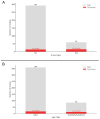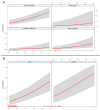Nationwide Screening Unveils Endemic Ophidiomyces ophidiicola Presence in Northern Italy, Mainly Affecting Dice Snakes: Evidence from Contemporary and Historical Snake Samples
- PMID: 39997412
- PMCID: PMC11856666
- DOI: 10.3390/jof11020118
Nationwide Screening Unveils Endemic Ophidiomyces ophidiicola Presence in Northern Italy, Mainly Affecting Dice Snakes: Evidence from Contemporary and Historical Snake Samples
Abstract
Ophidiomycosis, caused by the keratinophilic fungus Ophidiomyces ophidiicola (Oo), is an emerging threat to snake populations, yet its epidemiology in Europe remains underexplored. We investigated the distribution of Oo across free-ranging snake populations in Italy, integrating both recent field samples and historical museum specimens. Our survey involved 423 snakes representing 17 species from 17 regions, with Oo detected in 32 snakes from five different species. Additional molecular detection for Parananniziopsis spp. on a subset of 13 Oo-negative samples from snakes that exhibited clinical signs yielded negative results. Acknowledging the non-standardised sampling and the limited sample size, our findings highlight Oo's persistent and widespread presence across diverse ecological zones, particularly affecting semi-aquatic species like Natrix tessellata. While Oo Clade I was primarily found in museum specimens, indicating a historical presence, Clade II prevailed in recent samples. This highlights a complex epidemiological landscape where different clades may influence the current disease dynamics. Our results underscore the importance of continuous surveillance and highlight the need for standardised sampling to better understand snake fungal disease ecology and epidemiology in Italy.
Keywords: EIDs; Europe; Natrix; SFD; fungal pathogens; infectious disease; mediterranean; ophidia; ophidiomycosis; serpentes.
Conflict of interest statement
The authors declare no conflicts of interest.
Figures







References
-
- Böhm M., Collen B., Baillie J.E.M., Bowles P., Chanson J., Cox N., Hammerson G., Hoffmann M., Livingstone S.R., Ram M., et al. The Conservation Status of the World’s Reptiles. Biol. Conserv. 2013;157:372–385. doi: 10.1016/j.biocon.2012.07.015. - DOI
-
- Filippi E., Luiselli L. Status of the Italian Snake Fauna and Assessment of Conservation Threats. Biol. Conserv. 2000;93:219–225. doi: 10.1016/S0006-3207(99)00138-X. - DOI
-
- Cox N.A., Temple H.J., IUCN Red List Programme; IUCN Regional Office for Europe; IUCN Species Survival Commission; IUCN—The World Conservation Union, European Commission; Office for Official Publications of the European Communities, editors. European Red List of Reptiles. IUCN; Office for Official Publications of the European Communities; Gland, Switzerland: Luxembourg: 2009.
Grants and funding
LinkOut - more resources
Full Text Sources
Medical
Miscellaneous

